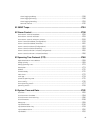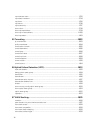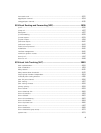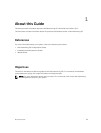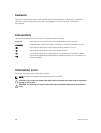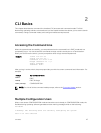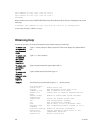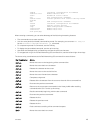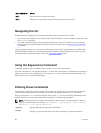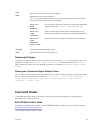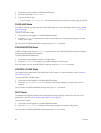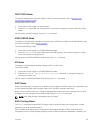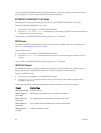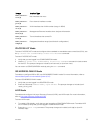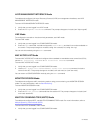
radius Interface configuration for RADIUS
redirect-list Named redirect-list
route Establish static routes
scp SCP configuration commands
source-route Process packets with source routing header
options
ssh SSH configuration commands
tacacs Interface configuration for TACACS+
telnet Specify telnet options
tftp TFTP configuration commands
trace-group Named trace-list
trace-list Named trace-list
Dell(conf)#ip
When entering commands, you can take advantage of the following timesaving features:
• The commands are not case-sensitive.
• You can enter partial (truncated) command keywords. For example, you can enter int teng 1/1
for the interface tengigabitethernet 1/1 command.
• To complete keywords in commands, use the TAB key.
• To display the last enabled command, use the up Arrow key.
• Use either the Backspace key or Delete key to erase the previous character.
• To navigate left or right in the Dell Networking OS command line, use the left and right Arrow keys.
The shortcut key combinations at the Dell Networking OS command line are as follows:
Key Combination Action
CNTL-A Moves the cursor to the beginning of the command line.
CNTL-B Moves the cursor back one character.
CNTL-D Deletes the character at the cursor.
CNTL-E Moves the cursor to the end of the line.
CNTL-F Moves the cursor forward one character.
CNTL-I Completes a keyword.
CNTL-K Deletes all the characters from the cursor to the end of the command line.
CNTL-L Re-enters the previous command.
CNTL-N Returns to the more recent commands in the history buffer after recalling
commands with Ctrl-P or the up Arrow key.
CNTL-P Recalls commands, beginning with the last command.
CNTL-R Re-enters the previous command.
CNTL-U Deletes the line.
CNTL-W Deletes the previous word.
CNTL-X Deletes the line.
CNTL-Z Ends continuous scrolling of the command outputs.
Esc B Moves the cursor back one word.
CLI Basics
49



